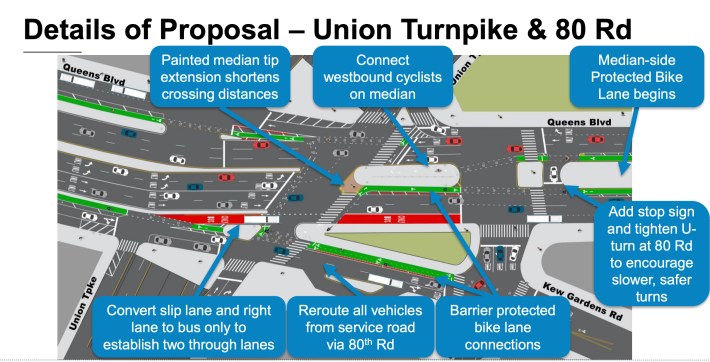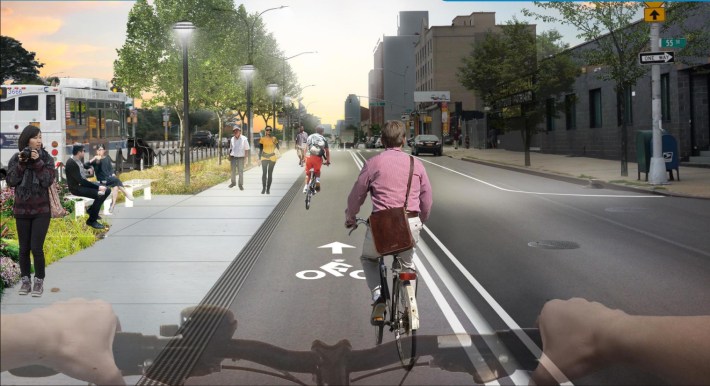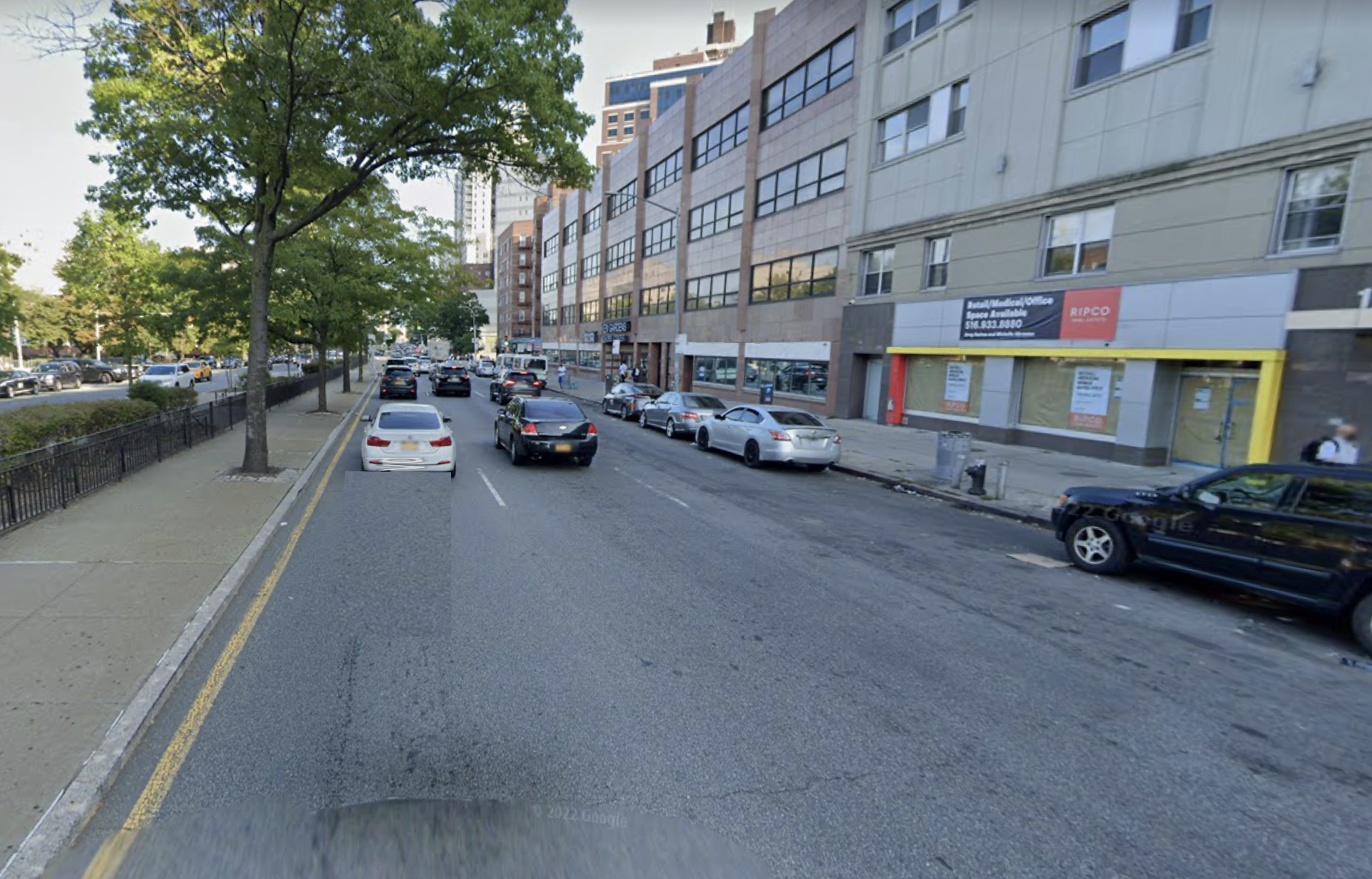The city finally plans to extend the bike lanes on Queens Boulevard further east into the World's Borough, fulfilling a promise officials made nearly a decade ago to overhaul the corridor once known as the "Boulevard of Death."
In a presentation last week [PDF], the Department of Transportation said it would repurpose a travel lane in each direction for bike lanes between Union Turnpike in Forest Hills and Hillside Avenue in Briarwood, while also installing infrastructure for pedestrians and buses. Advocates cheered Mayor Adams for bringing the upgrades to communities of color that lack safe street infrastructure.
“[Adams] wants to see equity being brought into the planning process and the bike network expansion process, You can’t think of a more equitable portion of the Queens Boulevard redesign,” said Juan Restrepo, the director of organizing at Transportation Alternatives.
DOT launched the Queens Boulevard overhauls in 2015 and originally planned to redesign the highway-like road from Long Island City to Jamaica, but the project faced setbacks, mostly from community board members seeking to retain the car-friendly status quo, for years.

The latest 1.2-mile eastward expansion runs past Queens Borough Hall and the courthouses in Kew Gardens, and continues to Hillside Avenue, just a block short of the boulevard’s eastern terminus at Jamaica Avenue. The agency noted that “further bike connections [are] under study,” on a slide showing the eastern end.
DOT will remove one of three car travel lanes in each direction for the bike paths running along the center median, add dedicated left turns with signals off Queens Boulevard, extend medians with paint to give pedestrians more space and discourage reckless driving.

Cyclists ride along the service road on the existing bike lanes to the west, but they will have to make a switch to the median at Union Turnpike, a complicated intersection with a lot going on (see below).
DOT is also converting an east-bound slip lane and a car lane into short bus lanes there and at 80th Road.

The thoroughfare currently has 40-foot-wide roads on each side of the median with three lanes in each direction and large open intersections, encouraging drivers to routinely speed and make dangerous turns, according to DOT.
Nearly 80 percent of drivers were breaking the speed limit when DOT inspectors checked, and they found someone going as fast as 52 miles per hour in the middle of the day. There’s also frequent double parking near Hillside Avenue and outside Queens Borough Hall, leading to more chaotic conditions on the road.
The nearly eight-mile boulevard cutting through Queens has long been on DOT’s list of Vision Zero priority corridors with a rate of 4.1 pedestrians killed or seriously injured per mile.

On the section slated for the latest upgrades, 233 people have been injured over five years, six of them severely, according to DOT. City records also show that there have been more than 600 reported crashes over the same period, injuring 35 pedestrians and cyclists.
A driver killed a 55-year-old Jaipaul Persaud at 84th Drive in 2021, and in 2012 a motorist fatally struck cyclist Alex Martinez near Hoover Avenue on his 37th birthday.
The chair of Community Board 8 Martha Taylor said the proposal was “well thought out” because the bike lanes will not remove parking along the curb, but said she had concerns.
“I’m very cautious about bike lanes because I’m very afraid somebody will get seriously hurt,” Taylor told Streetsblog.
However, DOT credited the existing bike lanes on Queens Boulevard to the west with a 34-percent reduction in injuries, 42 percent fewer pedestrian injuries, and a doubling of the number of cyclists.
Protected bike lanes also reduce the number of pedestrians killed or seriously injured by almost 30 percent — including almost 40 percent among seniors — and 16 percent for all road users, according to agency stats.
The bike lanes were originally supposed to be done by 2018, but faced years of delays, including when former Mayor Bill de Blasio threw his own Transportation Commissioner under the bus, stalling the revamp to pander to pro-car pols.
De Blasio didn’t wrap up the section connecting to Union Turnpike until 2021, and advocates pushed DOT to go all the way to Jamaica, but it was unclear if DOT would go any further, with City Hall officials at the time calling the Forest Hills stretch the “final phase.”
"It’s really good to see that DOT didn’t forget and they put this together," said Peter Beadle, a Queens volunteer with Transportation Alternatives who lives at the bike lane's current terminus in Rego Park and Forest Hills. "Queens Boulevard is one of the major arteries of Queens ... and it’s been a huge issue that there wasn’t a fully safe corridor all the way to Jamaica."
The painted revamps are the precursor for a bigger buildout of the medians and bike lanes, creating raised paths for cyclists and expanded concrete pedestrian space, which would make Queens Bouelvard look more like its sister boulevard on Eastern Parkway in Brooklyn or Allen Street in Manhattan.

That capital project was originally supposed to start in 2019, and drivers have often ignored the current painted paths by driving or parking in them. DOT plans to harden bike lanes from 72nd Street to Grand Avenue, the agency announced last month.
“We’ve been living with paint and plastic for way too long and I’m excited to see what’s coming next,” Beadle said.
DOT did not provide a timeline for the redesign or the future capital upgrades by press time.






